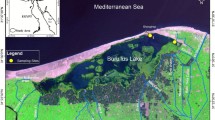Abstract
Food intake, growth and conversion efficiency of two larvivorous fishes have been studied by supplying different proportions of first instarCulex fatigans larvae andTubifex tubifex worms. The worms inhibit the preferential feeding on mosquito larvae byGambusia affinis andPoecilia reticulata. The reduction is more marked inG. affinis than inP. reticulata. Growth and conversion efficiency ofP. reticulata surpassed the values observed forG. affinis indicating that the mosquito larvae are better utilised byP. reticulata than byG. affinis.
Similar content being viewed by others
References
Bay E C 1972 A preliminary assessment of the potentialities of larvivorous fishes forAnopheles control in West Africa; WHO/VBC/72 403; p. 10
Galinat A 1960 Experimental studies on the utilization of natural food by young crucian (Carassius L.) and tench (Tinca tinca L.);Pol. Arch. Hydrobiol. 8 129–152
Gerberich J B and Laird M 1965 An annotated bibliography of papers related to the control of mosquitoes by the use of fish;WHO/MAL 66 562
Hess A D and Tarzell C M 1942 The feeding habits ofGambusia affinis with special reference to the malaria mosquitoAnopheles quadrimaculatus;Am. J. Hyg. 35 142–151
Idem 1948 Acclimatization of the ‘millions’Lebistes reticulatus (Peters) in Madras;Curr. Sci. 17 157–158
Katre S 1973Ecophysiological studies on growth and reproduction of some thermoconformers Ph.D. Thesis, Bangalore University, Bangalore p. 134
Katre S 1975 Effects of temperature-salility combinations on the digestion rates ofGambusia afinis;Proc. Indian Acad. Sci. 81 249–253
Katre S and Reddy S R 1977 Influence of body weight/age on the food intake, growth and conversion efficiency ofGambusia affinis;Hydrobiologia 55 65–69
Katre S and Reddy S R 1979 Influence of temperature-salinity combinations on the food intake, growth and conversion efficiency ofGambusia affinis (Pisces);Pol. Arch. Hydrobiol. 26 423–427
Kinne O 1971Marine Ecology 1 Part 2 (London: Wiley Interscience) pp. 683–1244.
Krishnamurthy C 1978Studies on food intake, growth and conversion efficiency of a larvivorous fish; M.Phil. Dissertation, Bangalore University, Bangalore, p. 55
MacArthur R H 1960 On the relation between reproductive value and optimal predation;Proc. Nat. Acad. Sci. 46 143–145
Mann H 1935 Untersuchungen uber die Verdollung and Ausnutsung der Stickstoff-shustanz einiger Nahritiere durch Verschiedene Fische;Z. Fisch. 33 231–274
Menon M D and Chacko P I 1955 Food and feeding habits of freshwater fishes of Madras State, India;Proc. Indo-Pacific Fish Council Sec.II pp. 1–5
Nikolsky G V 1963The Ecology of Fishes (London and New York: Academic Press) p. 352
Pandian T J and Ponniah A G 1976 Energy cost of predation on mosquito in a larvivorous fish;Seminar on Genetic control of mosquitoes (abstract)39 29–30
Pandian T J and Reddy S R 1971 Experimental studies on the feeding habits of the mosquito fishGambusia affinis;WHO/VBC/71 282 p. 3
Reddy S R and Pandian T J 1972 Heavy mortality ofGambusia affinis reared on diet restricted to mosquito larvae;Mosq. News. 32 108–110
Reddy S R 1973Mosquito control through larvivorous predators, Ph.D. Thesis, Bangalore University, Bangalore p. 154
Reddy S R and Katre S 1976 Digestion rates of the larvivorous fishGambusia affinis in relation to the prey species;Vignana Bharati 2 95–97
Reddy S R, Katre S, Natarajan G N and Karigirivasan H 1977 Predatory efficiency ofGambusia affinis in relation to different illuminations;Indian J. Exp. Biol. 15 237–238
Sasa M, Kurihara T, Dhamvanij O and Harinasata C 1965 Studies on mosquitoes and their natural enemies in Bankok, Part 3. Observations on a mosquito-eating fish ‘guppy’Lebistes reticulatus breeding in polluted waters;Jpn. J. Exp. Med. 35 63–68
Windell J T 1967 Rates of digestion in fishes; inThe biological basis of freshwater fish production ed. S D Gerking, (London: Blackwell Sci. Pub.) pp. 151–173
Yamagishi H 1966 Ecological studies on the guppyLebistes reticulatus (Peters) II. Experiments on predation of mosquito larvae by guppies;J. Fac. Sci. Shinshu Univ. 1 79–92
Author information
Authors and Affiliations
Rights and permissions
About this article
Cite this article
Ravichandra Reddy, S., Shakuntala, K. Comparative studies on the food intake, growth and food conversion of two larvivorous fishes. Proc. Indian Acad. Sci. 88, 425–432 (1979). https://doi.org/10.1007/BF03179123
Received:
Revised:
Issue Date:
DOI: https://doi.org/10.1007/BF03179123




